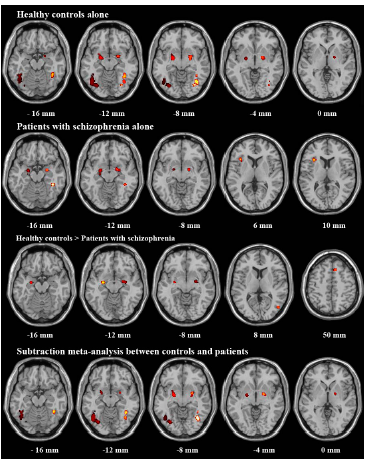|
People with schizophrenia have difficulty with emotion perception. Functional imaging studies indicate regional brain activation abnormalities in patients with schizophrenia when processing facial emotion. However, findings have not been entirely consistent across different studies. A most recent study done by Dr. Raymond Chan and Mr. Huijie Li (Neuropsychology and Applied Cognitive Neuroscience, and Key Laboratory of Mental Health of Institute of Psychology) have adopted a meta-analytical approach to consolidate these important datasets and help resolve the neural basis of facial emotional perception in schizophrenia. In this study, Dr. Chan’s team used an automated voxel-wise technique, activation likelihood estimation (ALE) to provide an objective, quantitative evaluation of facial emotion processing in schizophrenia. Seventeen functional imaging studies of facial emotion perception, sampling 257 patients with schizophrenia and 241 healthy controls, were included in the meta-analysis. Using GingerALE software, a localization probability distribution was derived from the co-ordinates reported across these studies and the distributions then combined to generate activation likelihood estimation maps. Statistical significance was assessed using permutation tests of the distribution against randomly generated sets of foci. Meta-analyses were conducted to examine brain activation during facial emotion processing in patients with schizophrenia, controls and in patients compared to controls. Secondary meta-analyses were performed to assess the contribution of task design and illness chronicity to the results reported. When processing facial expressions of emotions, both patients with schizophrenia and healthy controls activated the bilateral amygdala and right fusiform gyri. However, the extent of activation in these regions was generally much more limited in the schizophrenia samples. When directly compared to controls, the extent of activation in bilateral amygdala, parahippocampal gyrus and fusiform gyrus, right superior frontal gyrus and lentiform nucleus was significantly less in patients. Patients with schizophrenia, but not controls, activated the left insula. A relative failure to recruit the amygdala in patients occurred regardless of whether the task design was explicit or implicit, while differences in fusiform activation were evident in explicit, not implicit, tasks. Restricting the analysis to patients with chronic illness did not substantially change the results. The ALE meta-analysis reported here confirmed significant brain activation abnormalities during facial emotion perception in schizophrenia. A marked under-recruitment of the amygdala, accompanied by a substantial limitation in activation throughout a ventral temporal-basal ganglia-prefrontal cortex ‘social-brain’ system may be central to the difficulties patients experience when processing facial emotion. Such a fundamental disruption in the neural circuitry necessary for processing salient social stimuli needs to be examined in much greater detail in order to optimize this most valuable life-skill in our patients.
This study was supported partially by the Research Initiation Fund of the 100-Scholar Programme (O7CX031003), the Knowledge Innovation Project of the Chinese Academy of Sciences (KSCX2-YW-R-131) from the Institute of Psychology, Chinese Academy of Sciences, a grant from National Science Foundation of China (30770723), and the National Basic Research Programme (973 Programme No. 2007CB512302 and 2007CB512305).
This paper has been accepted by Schizophrenia Bulletin and is now available online
Li, H., Chan, R. C. K*., McAlonan, G. M., & Gong, Q. (2009). Facial emotion processing in schizophrenia : A meta-analysis of functional neuroimaging. Schizophrenia Bulletin, doi:10.1093/schbul/sbn190. (IF: 5.843).

|
